Posted: 12 Mar 2012 01:44 AM PDT 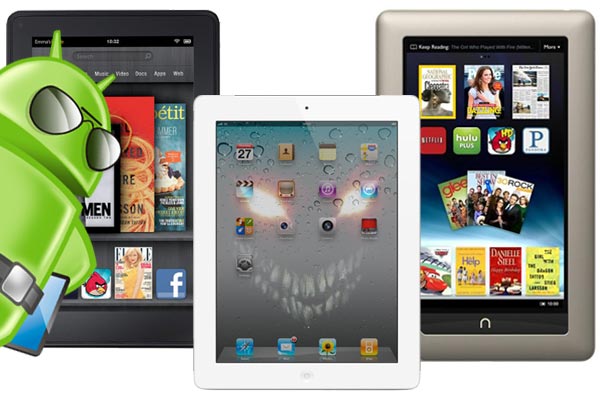 BGR reported today that Android tablet vendors are reportedly very concerned over rumors that Apple is working on a 7.85-inch "iPad mini", or is it an "iPod XL"? Android manufacturers, such as Amazon with their Kindle Fire, currently have a monopoly on 7-inch tablets. Apple already dominates the tablet market as a whole, boasting a 74% market share in the tablet market in 2011, but the 7-inch niche carved out by Android manufacturers has allowed them to survive and thrive within this space. It's difficult now to quantitate the impact a mini iPad would have on Android tablet vendors, but one important distinction to me is the price point of the two offerings. Apple may very well introduce a smaller tablet to compete with Android, but it won't be $199 – certainly not when the iPod Touch is priced at or above $199. An iPad mini would also be complete market cannibalization on Apple's part, most people who are interested in the iPad mini are going to be people who already own an iPod or iPad and prefer the 7.85-inch display to current Apple offerings. Many Android fans are hoping that 2012 will be the year of the Android tablet, backed by Google's announcement of a 7-inch Nexus tablet to debut in Q2. Regardless, if Apple does choose to enter this space, it is likely that competition will intensify even further. Apple’s shareholder’s already aren’t too pleased that are being forced to make significantly lower income on the latest iPad, and, if they choose to enter the waters with a 7 inch tablet offering to compete against Amazon and Google directly, it’s likely that you and I – the consumers – will be the direct beneficiaries of such heated competition. How do you think a 7.85-inch Apple tablet will impact the future of Android Tablets? This article, Should Android tablet manufacturers fear an “iPad Mini”? , was originally published at AndroidAuthority.com - Your Android News Source. |
Posted: 11 Mar 2012 11:15 PM PDT 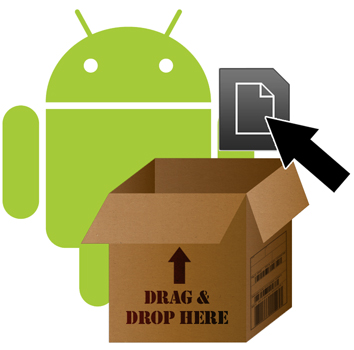 With the number of devices we’ve got at our disposal, it isn’t uncommon to remember that you’ve got a song you’d really want on your device but you simply don’t have time to sit down and plug your device into your computer just to transfer a single file. What if you’re very busy and you can’t expect yourself to take precious time out of your schedule, waiting for a file to finish transferring? Wireless is the way to go, and a number of apps have already stepped up to provide wireless transfers from your computer to your Android device. It saves you time and also leaves your hands free to do other things while you wait. Unfortunately, this transfer is a one-way road, from the computer to the Android phone. Wouldn’t it be great if you could transfer something, like a picture or a recording, from your device to your computer without having to succumb to using wires and eating up your time to hook the cable up? You can stop wishing on a star, because we’d like to introduce you to DropSpot, a minimalistic app that lets you access your Android phone’s files using any modern web browser, like Chrome. All you need is to connect the Android phone to the same Wi-Fi network your computer is using, enter the IP address provided on the app’s home screen, and you’re good to go! (Sidenote: If you’re looking for a way to transfer files between your Android device and computer without being on the same wireless LAN or Wi-Fi network, check out our review of EZ Drop.) 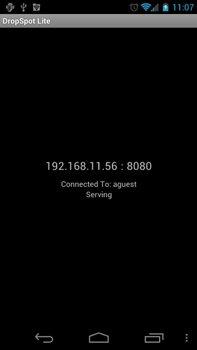 The web counterpart of DropSpot allows you to send files in a batch to your Android device, which is super handy when you’re not fond of sending files one at a time. DropSpot’s look is minimal and sleek, giving you everything you need without unnecessary distractions. DropSpot, to live up to its name, makes use of the drag and drop feature. Copy a file from your computer to your phone by dropping the file from your computer folder into your web browser. It also works if you want to move or copy a file within your Android phone. How handy and wonderful is that? It’s so intuitive that even the most technologically awkward users can find their way around it. 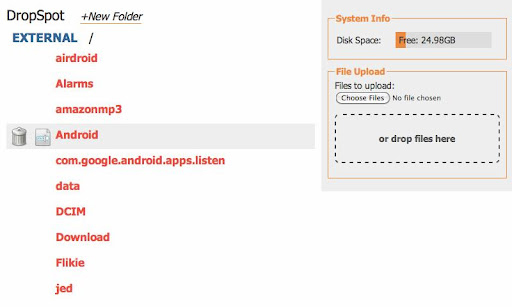 DropSpot’s Lite version is available on the Google Play Store for free and contains a lot of the same features as the full version. The only catch however is that you cannot upload files that are larger than 5 MB. If you’d like to remove the restriction, you may purchase the paid version of the app for US$1.99. Whether you’re using the Lite version, or planning to get the paid one, DropSpot requires Android v2.2 or higher to run. This article, DropSpot: Wireless File Transfers Between PC and Android Phone , was originally published at AndroidAuthority.com - Your Android News Source. |
Posted: 11 Mar 2012 02:14 PM PDT  Since the beginning of the smartphone revolution, just about every smart manufacturer has teamed up with carriers to release devices that would appeal to consumers not wanting to gouge their wallets. And, to this day, just about any carrier in the US, Canada or Europe offers inexpensive, or better – free phones, with a contract, of course. And you know for that price you usually never get the "best of the best", unless you come across pre-owned products. Today, Sprint has teamed up with ZTE to give us the Fury. The ZTE Fury certainly seems like a bargain, as $20 for an Android phone isn’t too bad, even if it’s not top of the line. These type of phones are primarily sold to attract first time buyers. Carriers use this tactic to help out the budget finders out there, but to also introduce the Android line to them so that maybe, next time, they will purchase a more expensive device. Anyway, the ZTE fury comes with a simple 1GHz single-core processor, 5 megapixel rear facing camera, 2.3 Gingerbread, 3.5 inch display, 4GB of internal memory and 3G compatibility. For the exact price of $19.99 on a 2-year contract, the phone seems like a steal. Even better, the device is brand new. The phone was just released today, so if you want yours make sure you "sprint" to the Sprint store before they sell like hotcakes. As each quarter passes, more and more technological wonder is being packed into entry level devices. It wont be long before we see a budget oriented, dual core device with a 4 inch plus screen. Have you picked up a Fury? How is it for the price? I would love to hear your comments on this entry-level device. This article, Sprint Welcomes the ZTE Fury Today – For Only $20! , was originally published at AndroidAuthority.com - Your Android News Source. |
Posted: 11 Mar 2012 01:38 PM PDT  While it seems like Google Navigation has been the longest BETA in history, a new update has been added to give the interface a more basic and efficient feel. It might not seem like a ton of changes have occurred, however the small differences could assist drivers when navigating through the menus. The update provides users with larger menu action buttons to enable them to quickly find what they are looking for. This certainly makes sense because when you are driving, it is a real challenge to interact with a touchscreen device, Thankfully, the small changes are welcomed, especially for those trying to navigate through cluttered traffic. Besides the larger buttons, the menu key to access all of these actions is no longer next the the soft keys in Android 4.0 ICS. The button is now integrated towards the top of the title bar. This addition rids the packed spacing between the soft keys. That about wraps up the update. Of course you can find Google Maps and Navigation in the "Play Store", if it is not yet on your device. Looks like you will not be hearing the terms "Android Market" much longer. So, if you have updated, have the changes added to your driving capability? Do you find it easier to have larger buttons than just a list? I would love to hear your comments on the new Google Maps Navigation update. This article, Google Maps Navigation Gets Update: A More Simple UI, For the Lost Wanderers , was originally published at AndroidAuthority.com - Your Android News Source. |
Posted: 11 Mar 2012 10:53 AM PDT  Microsoft Kinect certainly has been going places. Started as a mere motion controller for the company's Xbox 360 gaming system, the device's appeal has proven to be too much to resist for hobbyists, programmers, and tinkerers alike. Since then, we have seen the Kinect being used for all sorts of inventive if slightly wacky projects. The latest Kinect hack, created by Microsoft's own Hrvoje Benko, is one that you can wear. Prepare to feast your eyes on the Wearable Multitouch Projector. The demonstration may look like an unedited scene taken straight out of a Sci-Fi movie, and it definitely won’t get you a date on a Friday night. The basic idea of is to wear a special mount that places a projector and a Kinect camera right above your shoulder, which allows you to project onto any surface. But here's the twist, you can also interact with the projected image by using your arms and hands. In the video above, we have some great research out of Microsoft that shows that touchscreens with virtually no lag are on the horizon. 100 milliseconds? Please fool! We need that down to 1 millisecond! Like other masterpieces that took years to build and perfected, this is but a taste of what the final product would look like and could bring. Wearing it now won't help you make friends, but who needs those anyway? On the subject of innovation, the Android camp isn't doing too shabby in infiltrating itself into all sorts of future home appliances and electronics, which include watches, smart glasses, fridge, washing machine and cars. We have also compiled a list of innovative things that we expect to see on Android smartphones and tablets. But if all you ever really wanted was a cool-looking projector that doubles as a smartphone, then the Samsung Galaxy Beam has got your back. The Jetsons would’ve approved. Significant advances in projector technology are occurring as we speak, with hot shot technological analyst firms like Gartner saying they are going to be bundled into 100′s of millions of devices as early as 2015 and beyond. Could you ever see yourself actually interacting with a holographic / projected multi-touch interface? No related posts. This article, Microsoft Kinect Becomes a Wearable Multitouch Projector – and Other Great Innovations , was originally published at AndroidAuthority.com - Your Android News Source. |
Posted: 11 Mar 2012 10:16 AM PDT 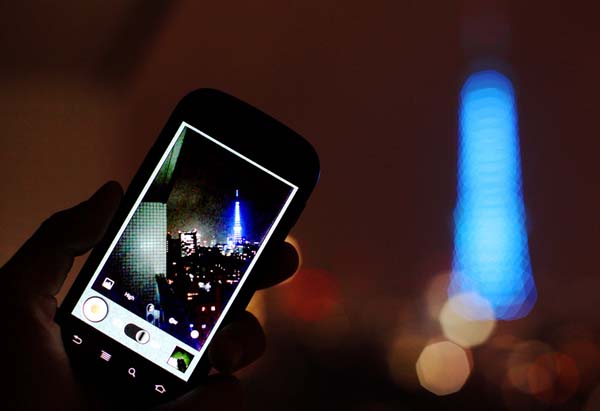 A quick look at the mobile device marketplace will only reveal one significant open source operating system that is used on phones and tablets. That is of course Android. The rest like iOS or Windows Phone 7 are proprietary, closed source platforms. It is impossible to tell what software is actually running on your phone, and what the phone is processing and analyzing in the background. A good example of this is the iPhone “Locationgate” scandal that erupted in the middle of last year. It was discovered that iOS 4 was collecting Wi-Fi hot spot and cell tower information and storing it on the phone for up to a year. Worse still this data was sent to your PC when the iPhone was synced with iTunes. Apple soon issued a fix and apportioned the blame to a bug and a bad choice in cache size. Since iOS is a closed system, there is no way we will ever know the truth. And since Android is open source this could never happen on an Android powered device. Or could it? The first question is this – is Android truly open source? The answer is – almost. Although Google do publish the source code for Android and lots of companies use it and spin off projects like CyanogenMod are based on it, the truth is that the firmware that runs on most Android powered devices isn’t a plain vanilla copy of the OS. First of all many of the supplementary components found in a mobile device, like the GPS chip, the camera or the modem, use proprietary drivers which the component manufacturers supply in a binary-only format. The phone maker just includes that binary in the build and lets it work its magic without any real knowledge of what is going on under the hood. Secondly phone makers (or more specifically mobile data network providers) often include extra software on devices (like Carrier IQ) for monitoring and statistic collection. This means the version of Android running on your phone is based in part on the source code released by Google, plus third party proprietary drivers, plus third party applications added by the phone maker or network. Worrying?The average mobile device contain more private information than most teen diaries plus they are equipped with Internet access, have built-in cameras and a microphone. This makes such devices an inherent privacy risk. Recently the Free Software Foundation (FSF) launched its “Free Your Android!” campaign in an attempt to educate consumers on the possible dangers of an “almost” open source Android.What does this mean to the average user? To be honest not too much. Although these issues are real and although it is theoretically possible for a GPS chip manufacturer to insert some secret code into the driver binary to track your location, the real danger is with the applications we run on our phones. Tweeting with location data incorporate in our tweets has exactly the same effect as any rogue GPS chip manufacturer and users are doing this willingly. Posting everything we do on Facebook including photos is far more harmful than the possibility that the FBI is trying to contaminate phones with secret code to capture images via the camera. Allowing Google to tie together your Android account, your Gmail account, your YouTube account, your Blogger account and then create a profile of you is just as harmful as allowing Carrier IQ to record statistics about your phone usage. We live in a mobile world and in many ways the privacy war has already been lost. The moment I switch on my phone my network provider knows where I am (and has done so for nearly two decades now). Such information has been used to convict murders and without a doubt it has been used by intelligence services to spy on people. And yet here we are twenty years later and we are still buying and using mobile devices. The best we can do is try to control what data gets shared about us via the applications we use.  Liberate Your Device!However, for the geeks out there, the FSF has some recommendations on how to liberate your Android device. Firstly it suggests installing a truly free version of Android like Replicant. The Replicant project is an attempt to create a version of Android that is 100% open. Unfortunately it runs only on a very limited number of devices. If you can’t run Replicant, the FSF recommends CyanogenMod, but it does concede that the project “makes use of non-free device drivers and firmware.”ConclusionDon’t be complacent in thinking that Android is open source and therefore better at respecting your privacy. It isn’t. In fact Google rely on the fact that you use its services via your phone to target you with adverts based on what you are doing and where. But most of all worry about what applications you are running on your phone and what personal, private information you are willingly sharing.This article, Does Android’s Open Source Status Make it Better in Terms of Privacy? , was originally published at AndroidAuthority.com - Your Android News Source. |
Posted: 11 Mar 2012 10:14 AM PDT 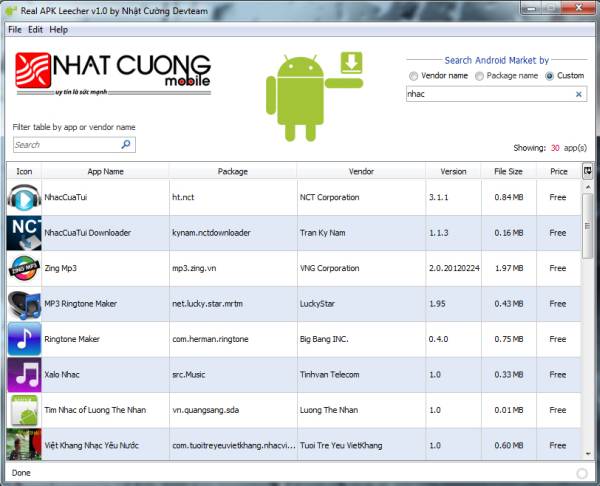 While Google Play (formerly the Android Market) is fairly reliable on, there are times when certain apps are unavailable for download on your Android smartphone for various reasons (for example: the App might not be available in your country, etc). If you find yourself dealing with this problem, don't despair as now, thanks to a unique tool by the name of Real APK Leecher, you can download any .apk file from Google Play to your computer. Once that's done, all that remains is that you transfer the file from your computer to your Android smartphone. Next up, I'll show you how to accomplish both these tasks with an easy, step-by-step tutorial. Phase 1: Downloading the .APK file on your computerStep 1: Download the Real APK Leecher tool. Use the link right here to get the archive, then unzip it to the destination folder of your choice on your computer. There is no install process, but the tool does require Java Runtime Environment 1.5.0 to be installed on your computer. If you don't have it (or are unsure if you do), do not worry, as you'll be prompted to download it when you run the Real APK Leecher.Step 2: The first time you run Real APK Leecher, you'll be asked to fill in three fields: an email address and password referring a Gmail account that is the main account on your Android smartphone, and the device ID. If you know how to find all of them, skip to step 4. 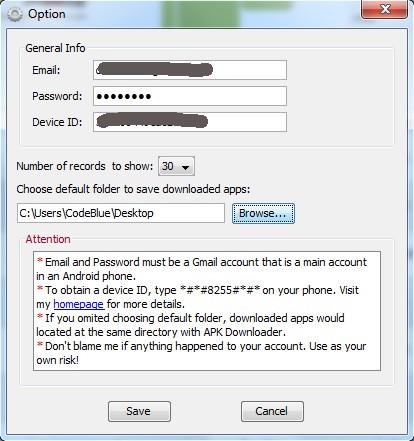 Step 3: Finding the market account can be done by opening up the dial pad on your Android smartphone and pressing *#*#8255#*#*. This should open up the "Gtalk Service Monitor". What follows after "JID" is your Google Play account. What follows after "Device ID: android-" represents the device ID. The following screenshot should help you if the above explanations aren't enough. 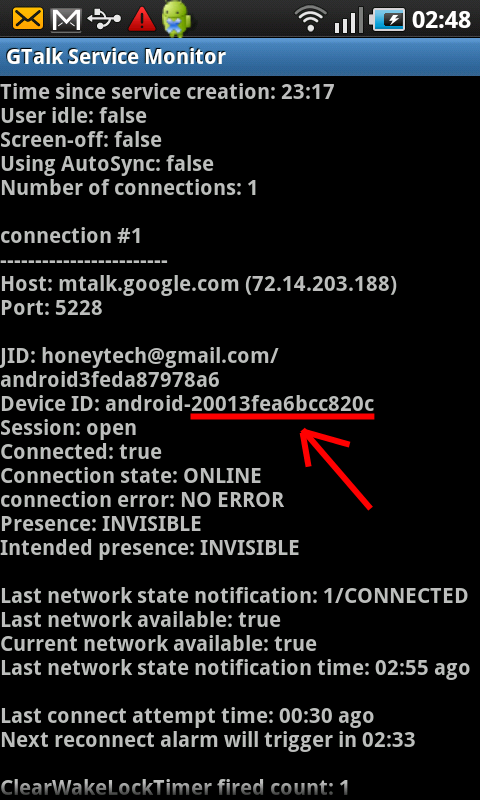 Step 4: Now all you have to do is search the app your want to download the APK for (you can choose to search both by the app’s name as well as by the name of the vendor). Once you found what you are looking for, right click it and select download. Phase 2: Transferring the APK file to your smartphone Next up, you can choose to transfer the APK file to your Android smartphone via an USB cable. That's not very "elegant" though, so I'll now teach you how to use WebSharing Lite to quickly transfer files (APK files included) from and to your computer via any Wi-Fi network. Step 1: Go to Google Play on your smartphone and download WebSharing Lite (the full version, priced at $2.99 allows you to upload multiple files, browse through media and stuff like that, but the Lite version is really all we need in this situation). Step 2: Turn on Wi-Fi on your smartphone and launch the WebSharing Lite app. Once the app is loaded, go to Menu -> Settings , then tap Owner account password. Enter your new password and click OK (the same password will be used for all future connections, so make sure it’s something easy to remember). Step 3: Back at the main screen, tap Start and WebSharing will display a URL. Go to your desktop, enter that URL, then the password you've set at the previous step. If you ever used Windows Explorer before (and what are the chances that you didn't?), you'll be fairly competent on how to transfer files back and forth between your desktop and your Android smartphone. Step 4: Remember the APK file that you've downloaded in Phase 1? Just transfer that file to your smartphone and you'll be set to go. That does it! Now you know how to download any app from Google Play first on your computer, then to your Android smartphone, thus bypassing geo-localization, as well as any other restrictions you might encounter in what once was called the Android Market. This article, How To Download Any APK To Your Computer , was originally published at AndroidAuthority.com - Your Android News Source. |
Posted: 11 Mar 2012 07:15 AM PDT 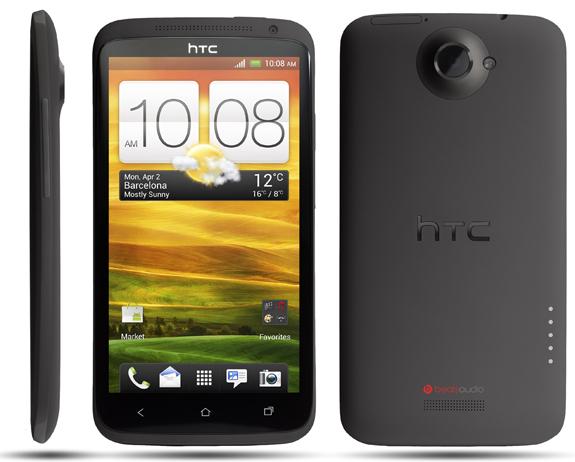 The HTC One X is likely to be the first quad-core smartphone in the world to reach the hands of consumers. As such, it is probably the most hyped smartphone out there at this point, with both Android-related (us included), as well as general tech sites eagerly reporting every small bit of available information about HTC's next flagship superphone. Add to the fact that HTC is equipping all smartphones in the One series with a new and improved camera technology, as well as the fact that the One X will launch with Google's Android 4.0 Ice Cream Sandwich out of the box, makes it sense enough that people are very excited to get their hands on it. Unfortunately for HTC's fans from the United States, the HTC One X will not be officially supported by any carrier (at least according to the information we have so far). Granted, a dual-core version of the HTC One X will reach AT&T as the HTC One XL, but it's safe to assume the main attraction of the HTC One X is its quad-core Tegra 3 processor, so the XL doesn't seem to rock too many boats. If the last sentence speaks your thoughts, you'll be glad to learn that the Tegra 3 HTC One X has recently passed through the FCC, with support for AT&T's HSPA+ radios. What this means is that you'll be able to import an unlocked HTC One X (once it gets released in Europe in April – Amazon.co.uk and other European retailers will surely offer the unlocked version on their webstore sometime soon), stick in an AT&T SIM card and you'll be ready to go. Unlike the XL version, you won't be getting access to Ma Bell's LTE network but the slower HSPA+ data speed on a Tegra 3 smartphone seems to be a compromise many of us are willing to make. No LTE but quad core still good? Let us know! This article, The HTC One X Passes Through The FCC With Quad-Core Tegra 3 On Board , was originally published at AndroidAuthority.com - Your Android News Source. |
Sunday, April 15, 2012
Update - 193
Subscribe to:
Post Comments (Atom)













No comments:
Post a Comment